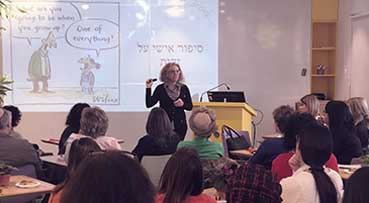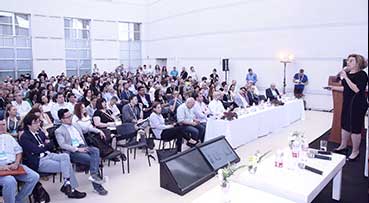As the war in Israel unfolds, organizations are rethinking talent strategies for business continuity. They’re grappling with reduced headcounts due to people being called into reserve duty and parents needing to stay home with young children as schools close. The first signs of this shift are visible at the supermarket, where new faces are stocking shelves and a fresh set of cashiers have appeared. When I inquire, I learn that these workers have been dispatched from corporate headquarters to address labor shortages on the ground. Meanwhile, an HR manager at a manufacturing plant sends out a WhatsApp message seeking “young people before college” for a crucial production line requiring rapid expansion. Moments after her message goes live, she retracts it. When I ask why, she says she anticipated 20-30 responses but received an overwhelming 6,000 within a day. Ordinarily, she notes, roles like this are hard to fill, but people are now volunteering for these fully-paid positions.
Crises frequently serve as incubators for innovation, breaking our reliance on established operational methods. Historically, wars have been potent catalysts for the transformation of labor markets. During WWII in Britain, for example, women assumed roles as bus and train drivers, even venturing into completely new professions. Likewise, African Americans coming back from the Korean War ignited calls for expanded labor market rights in the U.S. This week’s WorkFutures article delves into strategies for maintaining talent and business continuity amid the disruptions caused by the ongoing war in Israel. However, as you’ll see, these insights apply far beyond wartime scenarios, equipping us to navigate a work landscape that is increasingly unpredictable, volatile, and in constant flux.
Inside the Organization
Within an organization, numerous employees are open to diversifying their roles, either partially or temporarily. This willingness isn’t just born out of necessity or management directive; it’s also fueled by an authentic desire to cultivate new skills and experiences that are otherwise unattainable. Take, for example, corporate staff dispatched to supermarkets during a crisis. They gain invaluable, firsthand insights into the lives of frontline workers, uncovering needs and opportunities that are often overlooked from their ivory towers. Consider the eye-opening experiences awaiting a finance professional who observes the daily grind of a supermarket or a manufacturing floor. Or ponder how an HR manager’s approach to recruitment might be transformed after walking a mile in the shoes of the roles she’s hiring for. This exercise in role fluidity isn’t just enlightening—it’s an imperative, even for senior management.
Dissect Roles into Tasks for Greater Flexibility
Contrary to conventional wisdom, role flexibility doesn’t have to entail a complete role reversal; tasks can be redistributed independently of established titles. Job descriptions, often considered sacrosanct, are merely collections of tasks that have been bundled together over time into formal organizational roles. If you unbundle these tasks from their traditional titles, you unlock the potential for a more agile and adaptive work environment. Consider corporate staff working supermarket shifts. They don’t need to abandon their main responsibilities; they can simply commit to a few shifts a week, either offsetting less crucial tasks or passing them on to colleagues eager for a new challenge.
Taking this idea even further, we could be laying the groundwork for an internal gig economy—a reservoir of in-house freelancers willing to take on tasks that fall outside their formal job descriptions. The value of such an approach becomes palpable in emergency situations, but its utility extends to normal circumstances as well. This model creates a natural alignment, matching tasks with individuals who have a genuine interest in, and may even be invigorated by, performing them.
The benefits of this approach also extend beyond the organizational boundaries. Once tasks are unbundled, they can be outsourced to a versatile, external labor force. Abandon the outdated notion of full-time commitments for less glamorous roles; these modular tasks can be picked up by individuals content with just a few shifts a week. Companies like Wolt have successfully applied this model, assembling a fleet of part-time couriers who work according to their own schedules. During crisis periods, this framework serves as a financial safety net for freelancers and the self-employed seeking temporary financial relief.
Forget the Long-Term, Focus on the Now
The military strategist Clausewitz aptly described war as a “realm of uncertainty,” a sentiment that resonates deeply in today’s unpredictable work landscape. In a world where change is the only guarantee, the move toward temporary arrangements over long-term commitments should be expected, not feared. Reflecting on my experience of hiring for a high-tech factory in a remote location in Israel, conventional wisdom would advocate for securing long-term loyalty in the face of fierce competition for top talent. We chose a different route. We offered two-year tenures to young people fresh out of mandatory military service, fully expecting many of them to be transient, as they saved for further education or travel. To our surprise, the majority chose to stay at the end of their two-year term, debunking the myth that long-term commitments are the ultimate goal for talent acquisition.
The nostalgic notion of lifelong employment with a single company is long gone. Still, many organizations continue to recruit as if this antiquated model is the standard. The reality is, the promise of long-term stability doesn’t resonate with everyone, especially when targeting demographics that are unlikely to stick around. The same flexibility people show in diverging from their “ideal career paths” during crises exists in everyday circumstances as well. Being upfront about shorter-term opportunities can be a winning strategy, attracting individuals for whom the timing, rather than the duration of the commitment, is just right.
Focus on What’s Needed, Not Who’s Needed
When I conversed with the HR manager who resorted to WhatsApp to expediently fill positions at her manufacturing plant, she admitted the message’s informal tone was a departure from their usually meticulous job postings. However, pressed by urgency, she prioritized quick results over polished language, reaching her target audience through non-traditional avenues. Consider the shift in outcomes if she had laid out the specific tasks required for the role rather than the ideal candidate profile. By concentrating on the ‘what’ over the ‘who,’ organizations can draw in talent that might not match the conventional description but can execute the essential tasks.
Additionally, empowering candidates to outline their preferred working conditions can make traditionally less appealing roles suddenly enticing, but in a different setting. A manufacturing job with long shifts and modest compensation may not capture the interest of younger job-seekers but could be perfect for those early in their careers or juggling academic commitments.
To unlock this untapped well of talent, organizations must also update their recruiting strategies. The potency of personal networks, particularly in tightly-knit communities, cannot be underestimated. Current employees or associates of a company can convey job specifications to fitting candidates far more effectively than the most well-crafted job listing. This explains why a hurriedly composed WhatsApp message achieved what traditional methods couldn’t.
Your Talent Network is Bigger Than You Think
Your resource pool extends beyond current employees; it encompasses former staff—whether retirees, contractors, freelancers, or employees who’ve moved on. Crafting skill-centric, flexible job descriptions can entice these valuable contributors back as part-time workers, consultants, or temporary hires. For instance, a retiree might welcome the chance to work a few days a week, while an ex-employee now focused on parenting or studying might desire flexible hours. Don’t overlook the untapped assets within your employees’ families. Struggling to recruit digitally savvy young talent? Capitalize on your older workforce’s connections; their children or relatives could be the very talent you’re seeking.
And don’t forget your suppliers and business partners. They could harbor precisely the talent suited for your immediate needs. Consider the scenario where supermarkets remain open, but malls shut down. Cross-industry collaboration could facilitate seamless workforce transitions. This kind of agility is not just crisis-oriented; it also solves a perennial challenge for industries grappling with seasonal workforce fluctuations. Progressive companies recognize that retaining talent might involve providing external growth opportunities through partnerships with other companies. For instance, traditional businesses might enable their employees to freelance for tech startups or educational institutions, thus broadening their skill sets without leaving their primary roles.
Naysayers will inevitably question this approach, citing costs, logistical complexities, or procedural roadblocks as deal-breakers. But while we’re busy debating, platforms designed to enable these modern employment dynamics are already emerging. The wartime need we’re witnessing in Israel is not just about crisis resilience; it’s about adapting to an ever-changing work environment. By embracing a more layered, versatile talent and resource ecosystem that extends beyond traditional organizational limits, you’re doing more than just surviving diverse challenges. You’re thriving amid them, well-prepared for a future of work that is already unfolding before us.
United, we will win. 🇮🇱

![large-AX1A2125-2[1] large-AX1A2125-2[1]](https://niritcohen.com/wp-content/uploads/elementor/thumbs/large-AX1A2125-21-pnzedcs72atx5aeurqytqdiihxixlq02re9mlz805s.jpg)






